
What are the responsibilities of a virtual reality developer?
Virtual reality (VR) technology is becoming increasingly popular and has revolutionized various industries such as gaming, entertainment, education, and healthcare. As a result, there is an increasing demand for virtual reality developers who have the skills to create immersive and engaging experiences for users.
Responsibilities of a Virtual Reality Developer
Virtual reality developers are responsible for designing, creating, and testing virtual environments that provide an immersive experience for users. Their responsibilities include:
Designing Virtual Environments
Virtual reality developers are responsible for creating the 3D models, textures, and lighting of virtual environments. They use specialized software such as Unity, Unreal Engine, and Blender to design and create these environments. Additionally, they collaborate with other teams such as artists, designers, and programmers to ensure that the virtual environment meets the requirements of the project.
Creating Interactive Elements
Virtual reality developers are also responsible for creating interactive elements such as characters, objects, and animations. They use specialized software to create these interactive elements and ensure that they are responsive and intuitive for users to interact with. Additionally, they collaborate with other teams such as sound designers and music composers to create an immersive audio experience for users.

Optimizing Performance
Virtual reality environments can be complex and require significant processing power to run smoothly. Virtual reality developers are responsible for optimizing the performance of virtual environments to ensure that they run smoothly on various devices such as smartphones, tablets, and gaming consoles. They use specialized software to test and optimize the performance of virtual environments and ensure that they meet the requirements of the project.
Testing and Debugging
Virtual reality developers are also responsible for testing and debugging the virtual environment to identify and fix any issues that arise during development. They use specialized software to test the virtual environment on various devices and ensure that it meets the requirements of the project. Additionally, they collaborate with other teams such as quality assurance testers to identify and fix any bugs or issues that arise during testing.
Tools used by Virtual Reality Developers
Virtual reality developers use a variety of tools to create immersive virtual environments. These tools include:
- 3D Modeling Software: Virtual reality developers use 3D modeling software such as Blender, Maya, and Cinema 4D to create 3D models of virtual environments. These models are used to design and create the environment, including the terrain, buildings, and objects that will be placed in the environment.
- Texture and Lighting Software: Virtual reality developers use texture and lighting software such as Photoshop, Substance Painter, and Houdini to create textures and lighting for virtual environments. These tools are used to add detail and depth to the environment, making it more immersive for users.
- Virtual Reality Development Platforms: Virtual reality developers use virtual reality development platforms such as Unity, Unreal Engine, and A-Frame to create virtual environments. These platforms provide a variety of tools and features that make it easier to develop virtual environments, including support for various devices and integration with other technologies such as artificial intelligence and machine learning.
Challenges faced by Virtual Reality Developers
Virtual reality development can be challenging due to the complexity of creating immersive virtual environments. Some of the challenges faced by virtual reality developers include:
- Performance Issues: Virtual reality environments can be complex and require significant processing power to run smoothly. This can lead to performance issues such as lag, stuttering, and motion sickness. Virtual reality developers must optimize the performance of virtual environments to ensure that they run smoothly on various devices.
- Motion Sickness: Motion sickness is a common issue in virtual reality development. It occurs when the user’s senses are confused, leading to nausea and disorientation. Virtual reality developers must design virtual environments that minimize motion sickness and ensure that the user remains immersed in the environment.
- User Experience: Creating an immersive and engaging user experience is critical in virtual reality development. Virtual reality developers must ensure that the virtual environment is intuitive, responsive, and easy to use.


